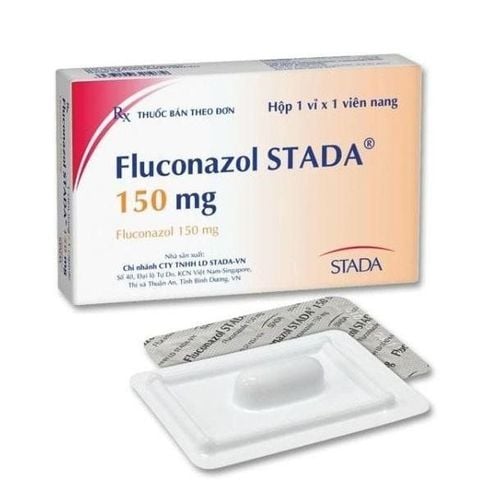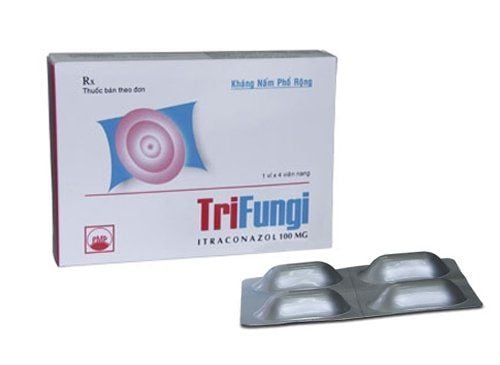This is an automatically translated article.
Canesten Cream is a drug commonly indicated in the treatment of fungal skin infections or fungal infections of the genitals. The article will provide readers with some information about the uses, dosage, side effects and notes when using Canesten.
1. What is Canesten Cream?
Canesten Cream belongs to the group of drugs for the treatment of dermatological diseases, with the main ingredient being clotrimazole 1%. Clotrimazole is a synthetic derivative of imidazole and has a chemical structure similar to miconazole. The mechanism of action of the drug is to bind to phospholipids in the fungal cell membrane, thereby altering the permeability of the cell membrane leading to loss of essential intracellular factors. The drug works to treat fungal infections of the skin; fungus on the labia and surrounding areas in women or on the foreskin and scalp of the penis in men.
Canesten is distributed in the skin as unchanged drug and the drug concentration decreases from the outside to the inside. The maximum concentration is in the stratum corneum and the drug is persistently present in the hair follicles. After topical application to healed or damaged skin, 0.1 to 0.5% of the drug is absorbed but not detected in serum (ie, blood concentrations below 1 ng/ml).
2. Uses of Canesten
Canesten Cream is indicated in the following cases:
Fungal infections of the skin caused by yeast, tinea, mold and other fungi (eg, tinea pedis, tinea pedis, tinea pedis, inguinal thrush). , tinea versicolor) and erythrasma (fungal disease caused by corynebacterium minutissimum). Fungi cause inflammation of the labia and surrounding areas in women Fungi cause inflammation of the foreskin and scalp of the penis in men
3. Dosage and usage of Canesten
3.1. How to use After washing the affected area, apply a thin layer of Canesten medicine, gently apply to the affected area and spread to the surrounding skin. Patients should apply twice daily, morning and evening, continuously for up to a month or at least two weeks after symptom resolution to prevent recurrence. Be careful not to scratch the skin before applying the medicine. It is necessary to keep the diseased skin area clean and dry, combined with personal hygiene and environmental sanitation to quickly heal. Symptoms usually improve within the first week of taking the drug. Although symptoms are relieved, patients should avoid stopping midway, but should continue taking the drug until the end of the course. If there is no improvement in symptoms after 4 weeks of treatment, the patient should contact the doctor to review the diagnosis or change another drug. Canesten should be discontinued if the condition worsens or if irritation occurs. For damaged skin with many scales, secretions, pus, dirty fluid should be cleaned before applying the medicine and avoid dressing or covering. 3.2. Dosage The duration of treatment depends on the disease. Patients should continue to apply the drug for a full course even after the symptoms are gone to prevent recurrence:
Tinea capitis: treatment for 3-4 weeks. Erythrasma: 2 - 4 weeks treatment. Ringworm : 1 - 3 weeks treatment. Vaginitis and fungal balanitis: treatment for 1-2 weeks. Patients should notify their doctor if symptoms do not improve after 4 weeks of treatment.
There is generally no risk of acute toxicity occurring after accidental application to the skin or ingestion. There is no specific antidote for Canesten overdose.
5. What are the side effects of Canesten?
When using Canesten Cream, patients may experience some side effects as follows:
Immune disorders: Allergic reactions (low blood pressure, difficulty breathing, urticaria). Skin and subcutaneous tissue disorders: Blisters, pain, discomfort, edema, skin peeling, pruritus, rash When the drug is applied to the genital organs, patients may experience burning sensation, polyuria, vulvar itching, vaginal discharge, vulvar pain, vulvar swelling
6. Notes when using Canesten Cream
Canesten is contraindicated in cases of hypersensitivity to topical clotrimazole or imidazole. Applying clotrimazole cream to the genitals can reduce the effectiveness and safety of latex items such as condoms and diaphragms. However, this effect is temporary and only occurs during treatment. Avoid contact with eyes and do not swallow Cetostearyl alcohol, which can cause local skin reactions (eg, contact dermatitis). Ability to drive and use machines: Canesten does not affect the ability to drive and use machines. Pregnancy: Information on the use of clotrimazole in pregnant women is limited. Animal studies have shown no direct or indirect harmful effects related to fertility problems. It is best to avoid clotrimazole during the first 3 months of pregnancy. Lactation: Animal data indicate that clotrimazole and its metabolites are excreted in milk. Therefore, patients should discontinue breast-feeding during treatment with clotrimazole. Drug Interactions: There are currently no reports of drug interactions with Canesten. Above is general information about Canesten Cream. If you have questions or need more information, you should contact your doctor or pharmacist for advice and answers.
Please dial HOTLINE for more information or register for an appointment HERE. Download MyVinmec app to make appointments faster and to manage your bookings easily.













